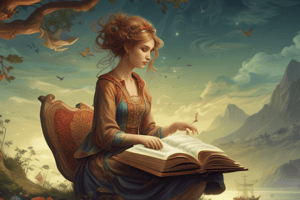Podcast
Questions and Answers
What is the primary function of metaphors in literature and poetry?
What is the primary function of metaphors in literature and poetry?
- To introduce new characters
- To summarize the plot of a story
- To convey complex ideas and create vivid imagery (correct)
- To create a sense of humor
Which of the following literary devices is used to make a comparison between two unlike things?
Which of the following literary devices is used to make a comparison between two unlike things?
- Personification
- Alliteration
- Simile
- Metaphor (correct)
What is the result of using metaphors and other literary devices in writing?
What is the result of using metaphors and other literary devices in writing?
- A less engaging and forgettable work
- A deeper and more memorable experience for the reader (correct)
- A more confusing and convoluted experience for the reader
- A shorter and more concise story
What is the purpose of understanding metaphors and their role in literature and poetry?
What is the purpose of understanding metaphors and their role in literature and poetry?
How do metaphors, as a poetic device, contribute to the exploration of abstract or complex ideas in poetry?
How do metaphors, as a poetic device, contribute to the exploration of abstract or complex ideas in poetry?
What is the significance of understanding the subtopics of figurative language, symbolism, and poetic devices in appreciating metaphors?
What is the significance of understanding the subtopics of figurative language, symbolism, and poetic devices in appreciating metaphors?
In the poem 'The Road Not Taken' by Robert Frost, what does the metaphor of the two roads represent?
In the poem 'The Road Not Taken' by Robert Frost, what does the metaphor of the two roads represent?
What is the common effect of using metaphors, as a poetic device, in poetry?
What is the common effect of using metaphors, as a poetic device, in poetry?
Why are metaphors considered a powerful tool for communication and understanding?
Why are metaphors considered a powerful tool for communication and understanding?
What is the primary purpose of using hyperbole in everyday speech?
What is the primary purpose of using hyperbole in everyday speech?
What is the effect of using hyperbole in literature and music?
What is the effect of using hyperbole in literature and music?
Why should hyperbole be used sparingly in writing?
Why should hyperbole be used sparingly in writing?
What is the characteristic of hyperbole that sets it apart from literal language?
What is the characteristic of hyperbole that sets it apart from literal language?
What is the role of hyperbole in creating a vivid image in literature?
What is the role of hyperbole in creating a vivid image in literature?
Flashcards are hidden until you start studying
Study Notes
Metaphors: Unleashing the Power of Figurative Language
Metaphors are a powerful tool in language, often used to convey abstract concepts, evoke emotions, and create vivid imagery in the minds of readers. They are a form of figurative language that compares two unrelated ideas, using one to explain the other. This article will explore the concept of metaphors, their use in literature, and their role as literary and poetic devices.
Understanding Metaphors
Metaphors are a form of figurative language that uses a comparison between two unlike things to create a deeper and more meaningful understanding of an abstract concept. They can be found in various forms of written and spoken communication, from academic writing to poetry, and are often used to help readers visualize and understand complex ideas.
Types of Metaphors
There are two main types of metaphors: conceptual metaphors and structural metaphors. Conceptual metaphors are based on general concepts, such as "love is a journey," while structural metaphors focus on specific aspects of an object or idea, such as "time is a river."
Symbolism in Metaphors
Symbolism is often used in metaphors to represent ideas, emotions, or concepts that cannot be directly expressed in words. For example, the heart can symbolize love, while a rose can represent beauty and sweetness. These symbols are used to create a deeper and more vivid understanding of the abstract concepts being conveyed.
Metaphors in Literature and Poetry
Metaphors are commonly used in literature and poetry to create vivid imagery and convey complex ideas. They can be found in works such as William Shakespeare's "Macbeth," where he uses the metaphor "It is a tale told by an idiot, full of sound and fury, signifying nothing," and in Robert Frost's "The Road Not Taken," where he uses the metaphor "The road less traveled."
Literary Devices and Poetic Devices
Metaphors are just one of many literary and poetic devices used in writing to create vivid imagery and convey complex ideas. Other devices include similes, personification, and alliteration. These devices are used to create a deeper and more memorable experience for the reader.
Conclusion
In conclusion, metaphors are a powerful tool in language, used to convey abstract concepts, evoke emotions, and create vivid imagery in the minds of readers. They are a form of figurative language that uses a comparison between two unlike things to create a deeper and more meaningful understanding of an abstract concept. Understanding the concept of metaphors and their role in literature and poetry can help writers create more engaging and memorable works.
Studying That Suits You
Use AI to generate personalized quizzes and flashcards to suit your learning preferences.




